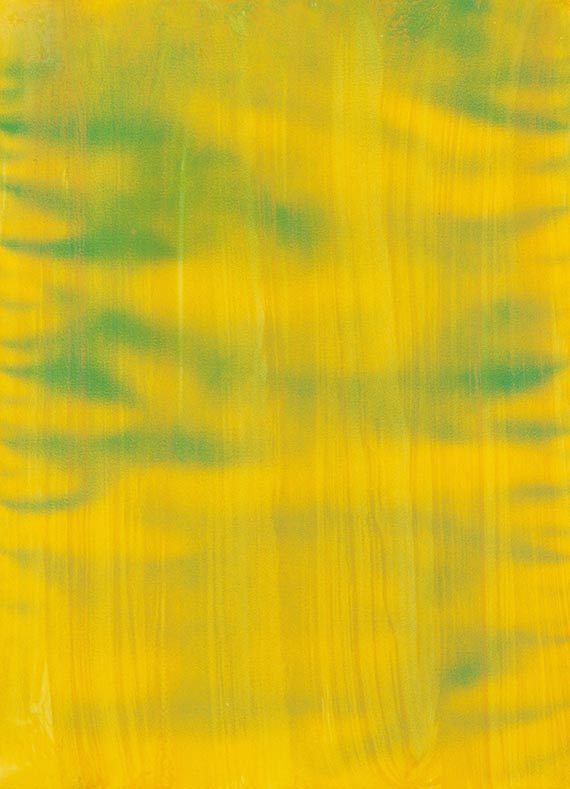Ohne Titel. 1999.
Acrylic.
Signed, dated, inscribed "Marfa 25" and with a direction arrow on the reverse. On T H Saunders wove paper (with the watermark). 54.7 x 39.7 cm (21.5 x 15.6 in), the full sheet.
[MH].
• Created in Marfa, Texas, where Grosse was a guest of the Chinati Foundation founded by Donald Judd.
• The striking combination of yellow and green makes for a dynamic tension between energy and calm.
• An impressive example of Grosse's ability to allow color to act as an independent element in the image.
• Works on paper by Grosse are extremely rare on the auction market.
PROVENANCE: Private collection, North Rhine-Westphalia (since 2000, acquired directly from the artisz).
In good condition. With unobtrusive signs of wear along the upper right and upper left edges.
Acrylic.
Signed, dated, inscribed "Marfa 25" and with a direction arrow on the reverse. On T H Saunders wove paper (with the watermark). 54.7 x 39.7 cm (21.5 x 15.6 in), the full sheet.
[MH].
• Created in Marfa, Texas, where Grosse was a guest of the Chinati Foundation founded by Donald Judd.
• The striking combination of yellow and green makes for a dynamic tension between energy and calm.
• An impressive example of Grosse's ability to allow color to act as an independent element in the image.
• Works on paper by Grosse are extremely rare on the auction market.
PROVENANCE: Private collection, North Rhine-Westphalia (since 2000, acquired directly from the artisz).
In good condition. With unobtrusive signs of wear along the upper right and upper left edges.
14
Katharina Grosse
Ohne Titel, 1999.
Acrylic
Starting bid: € 11,000 / $ 12,980
Headquarters
Joseph-Wild-Str. 18
81829 Munich
Phone: +49 89 55 244-0
Fax: +49 89 55 244-177
info@kettererkunst.de
Louisa von Saucken / Undine Schleifer
Holstenwall 5
20355 Hamburg
Phone: +49 40 37 49 61-0
Fax: +49 40 37 49 61-66
infohamburg@kettererkunst.de
Dr. Simone Wiechers / Nane Schlage
Fasanenstr. 70
10719 Berlin
Phone: +49 30 88 67 53-63
Fax: +49 30 88 67 56-43
infoberlin@kettererkunst.de
Cordula Lichtenberg
Gertrudenstraße 24-28
50667 Cologne
Phone: +49 221 510 908-15
infokoeln@kettererkunst.de
Hessen
Rhineland-Palatinate
Miriam Heß
Phone: +49 62 21 58 80-038
Fax: +49 62 21 58 80-595
infoheidelberg@kettererkunst.de
We will inform you in time.




 Lot 14
Lot 14 

